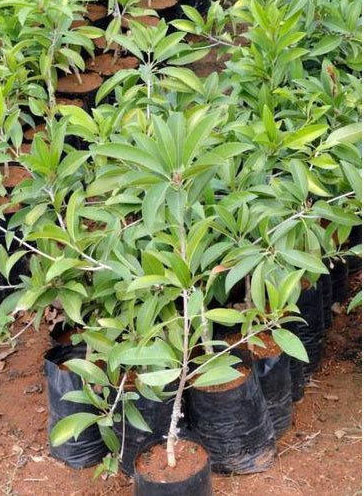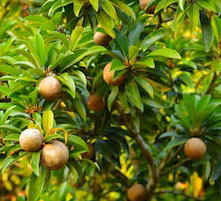Sapota
commonly known as “chiku” is an important fruit crop in India. Sapota
flowers throughout the year in tropical condition with two main seasons;
July to November and February to March. Inside, its flesh ranges from a
pale yellow to an earthy brown colour. The fruit may be
seedless or may have 3-5 black shinning seeds. It is an evergreen
tree.
Soil & Climate

Sapota is a hardy tree that can be grown on a wide range of soils – sandy loam, red laterite and medium black that are well drained, deep and porous. It can be grown from sea level up to 1200m above MSL in dry and humid areas where temperature ranges between 110C - 340C. It prefers a warm and moist weather and coastal climate seems to be best suited.
Propagation
Sapota is vegetatively propagated through approach or softwood grafting on ‘Khirnee’ Manilkara hexandra (Roxb.) rootstock.
Spacing
Sapota is generally planted with a spacing of 10m x 10m or 12m x 12m depending on the variety and soil type. A closer spacing of 8 m x 8 m or 8 m x 4 m can be followed to accommodate more number of plants, but thinning of plants may have to be done as the plantation gets older.
Planting
Pits of 60 cm3 or 90 cm3 are dug and filled with farm yard manure + top soil. Early monsoon is the best season to plant. Care should be taken to keep the graft joint at least 15 cm above the ground level. The soil around the graft is firmly pressed to anchor the plant in place and staking is provided to avoid wind damage. The plants have to be watered and protected from scorching sun.
 Training &
Pruning
Training &
Pruning
Sapota tree generally has well distributed branches and assumes uniform shape, hence does not need pruning every year. Moreover the flowers and fruits are produced almost throughout the year and there is little scope for pruning. However the shoots that appear below the graft joint and up to 90 cm from the ground level must be removed initially.
Irrigation
Sapota tolerates drought to some extent but responds to irrigation. Young plantations need to be irrigated during summer months at an interval of 6 to 8 days. Under drip irrigation, a fully grown plant of 8-10 years needs 40 to 50 liters of water per day during summer months and the quantity can be reduced by 50% during other seasons depending on the climate conditions.
Harvesting and Yield
Sapota fruits need to be harvested at maturity
which is a difficult task as judging the fruit maturity is done by
external symptoms only. The major visual symptoms include colour change
- fruit develops a dull colour at maturity which is generally related to
potato colour, reduction in the brown scurf on the fruit skin and latex
content. The harvested fruits have to be carefully collected and stored.
Any physical damage during harvest will affect the quality of fruits.
The peak harvest period in South India is October – November and March -
May. The yield depends on several factors like age of the tree, variety,
nutrition and the region of cultivation. A fully mature tree (15-20 year
old) can produce up to 3500 fruits per tree per year.